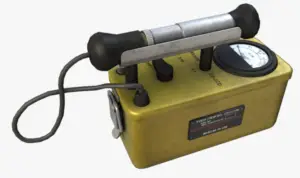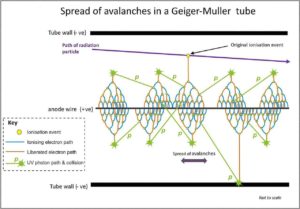
The Geiger counter, also known as the Geiger-Mueller counter, is electrical device that detects various types of ionizing radiation. This device is named after the two physicists who invented the counter in 1928. Mueller was a student of Hans Geiger. Geiger counter is widely used in applications such as radiation dosimetry, radiological protection, experimental physics, and the nuclear industry. A Geiger counter consists of a Geiger-Müller tube (the sensing element which detects the radiation) and the processing electronics, which displays the result.
Geiger counter can detect ionizing radiation such as alpha and beta particles, neutrons, and gamma rays using the ionization effect produced in a Geiger–Müller tube, which gives its name to the instrument. The voltage of detector is adjusted so that the conditions correspond to the Geiger-Mueller region.

Advantages of Geiger-Mueller Counter
- High Amplification. A strong signal (the amplification factor can reach about 1010) is produced by these avalanches with shape and height independently of the primary ionization and the energy of the detected photon. The voltage pulse in this case would be a large and easily detectable ≈ 1.6 V. The technical advantage of a Geiger counter is its simplicity of construction and its insensitivity to small voltage fluctuations. Since the process of charge amplification greatly improves the signal-to-noise ratio of the detector, the subsequent electronic amplification is usually not required.
- Simplicity. G-M counters are mainly used for portable instrumentation due to its sensitivity, simple counting circuit, and ability to detect low-level radiation. G-M detectors are generally more sensitive to low energy and low intensity radiations than are proportional or ion chamber detectors.
- Simpler Electronics. G-M detectors can be used with simpler electronics packages. The input
sensitivity of a typical G-M survey instrument is 300-800 millivolt, while the input
sensitivity of a typical proportional survey instrument is 2 millivolt.
Disadvantages of Geiger-Mueller Counter
- No particle identification, no energy resolution. Since the pulse height is independent of the type and energy of radiation, discrimination is not possible. There is no information whatsoever on the nature of the ionization that caused the pulse. G-M detectors can not discriminate against different types of radiation (α, β, γ), nor against various radiation energies. This is because the size of the avalanche is independent of the primary ionization which created it.
- Dead Time. Because of the large avalanche induced by any ionization, a Geiger counter takes a long time (about 1 ms) to recover between successive pulses. Therefore, Geiger counters are not able to measure high radiation rates due to the “dead time” of the tube.
We hope, this article, Advantage and Disadvantage of Geiger-Mueller Counters, helps you. If so, give us a like in the sidebar. Main purpose of this website is to help the public to learn some interesting and important information about radiation and dosimeters.